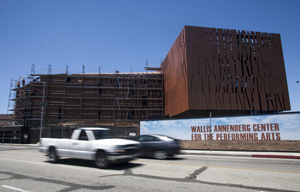
Beverly Hills, a city known globally for wealth and luxury, is taking the spotlight on another stage.
The Wallis Annenberg Center for the Performing Arts in Beverly Hills is nearing the end of construction and will join the local theater community this fall. Lou Moore, executive director, is excited for the opening, despite the prospect of financial challenges.
“Like any non-profit arts institution, fundraising is a constant,” Moore said. “And we have used these 10 years to build a constituency of funding for this project.”
Construction for the Annenberg Center started in April 2011 and was initially estimated to cost $30 million, to be funded with a capital campaign goal of $47 million, although those figures have changed.
Funding for the project was made possible through numerous donations, notably a $15 million grant from philanthropist Wallis Annenberg through the Annenberg Foundation in Los Angeles.
Moore said the Annenberg Center is still in its preopening fundraising efforts and will announce the end of the campaign and the final cost of the project in the next couple of weeks. The center is soliciting donations and sponsorships for its season of programming and special events.
Market expansion
The 500-seat theater, located at the northern tip of the city’s famed Golden Triangle shopping area, will be similar in size to the 499-seat Broad Stage in Santa Monica but larger than the 317-seat Kirk Douglas Theater in Culver City.
Visitors can expect special lectures and events along with a range of programming in theater, music, dance and opera, as well as programming for young audiences. The inaugural season will be announced at the beginning of August.
Like many theaters in Los Angeles, the Annenberg Center is a non-profit institution.
Stephen Rothman, professor of theater arts and dance at Cal State Los Angeles, said the cost of a production for a midsize theater like Annenberg Center can easily hit $150,000 but the venue receives little profit if ticket sales are slow. Therefore, it is no surprise that many theaters are non-profits.
L.A. theaters might be concerned that a new competitor will slice into their ticket sales, but Rothman disagrees.
He said the performing arts community has changed since he first led the effort to restore the Pasadena Playhouse in the 1980s.
“I think there was sort of a fear that there wasn’t enough of a theater audience in Los Angeles to support another major theater. But since then, look around,” said Rothman, who rattled off a list of theaters like the Geffen Playhouse in Westwood and the Kirk Douglas.
Moore, who was also the founding managing director of the Geffen, said there is an old adage in the performing arts that “good programming begets more good programming” and a large enough audience exists in Los Angeles to benefit all the theaters.
Wider impact
The Annenberg Center will feature a café, gift shop and production services as well as a theater school for young adults and children. The building incorporates the historic 1933 Italianate-style Beverly Hills Post Office into the contemporary theater.
Both buildings will be surrounded by a sculpture garden and terrace. Architect Zoltan Pali of SPF Architects in Culver City designed the project.
“Hopefully, it’s not a question of competing but expanding the market and fulfilling the need for more entertainment options,” said John Mirisch, mayor of Beverly Hills.
Having more entertainment options is also good for business, said Alexander Stettinski, executive director of the Beverly Hills Chamber of Commerce.
“Beverly Hills has not had a strong nightlife component, and Annenberg will absolutely contribute to it,” Stettinski said.
He has been eying the construction site outside his office window every day, and said that he expected local businesses, which will contribute about 70 percent of the city’s $183 million budget this year, will get a boost as more visitors who catch a performance can treat themselves to dinner or some shopping.
“Culture and art is what really unites generations,” he said. “I think art will equalize the environment and really make it conducive for people and all demographics to come to Beverly Hills and enjoy art like everyone else.”
